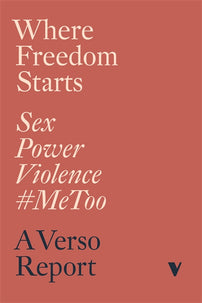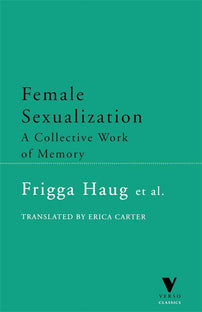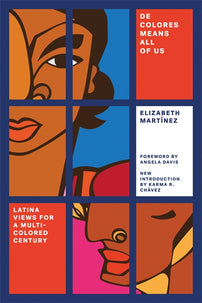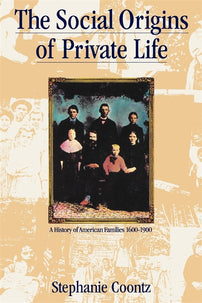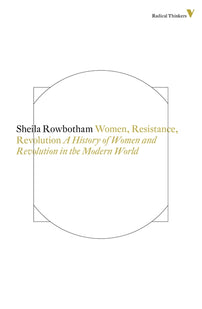Mindful Bodies and Forces of Nature
Three recent moments of the revitalized women's movement can be understood as windows into three levels of analysis and action: individual, social, and political.
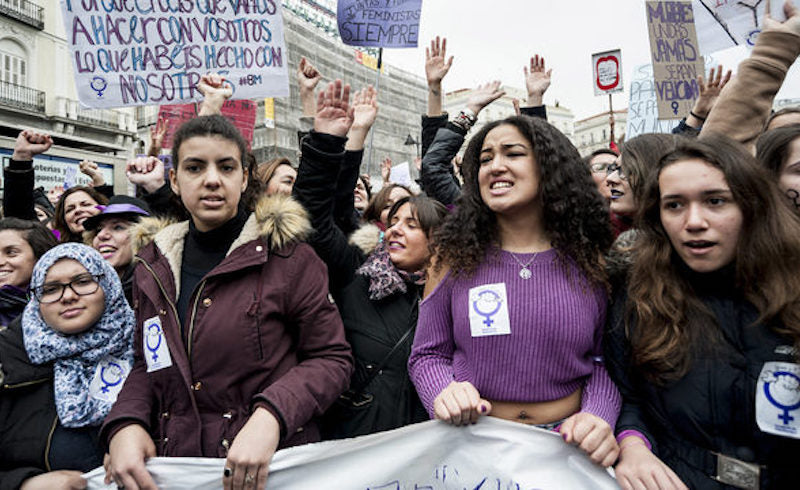
“We live in capitalism. Its power seems inescapable. So did the the divine right of kings. Any human power can be resisted and changed by human beings.” — Ursula Le Guin, October 21, 1929–January 22, 2018.
This winter we saw three major points of contestation for the still-growing movement of feminist outcry, discussion, and action; high water marks of the #metoo flood. First, revelations that feminist celebrity and dating humorist Aziz Ansari, had resorted on a date to tired scripts of coercion and male entitlement, and the subsequent backlash or (or backwash) from critics accusing feminists of “going too far” in this case. Second the unexpectedly robust Women’s March, back for a second year, along with attendant criticisms from both left and right, feminist and anti-feminist participants and observers. Third, the sentencing of Larry Nassar, doctor to Olympic and aspiring girl gymnasts, who was convicted of 10 counts of criminal misconduct and possession of child pornography, and implicated in 144 victim impact statements of a three-decade career of molesting girls and young women under his care — a cathartic event that put both the victims’ righteous rewriting of history and the carceral ends of courtroom justice on full display.
There are certain tensions around each event and between them. Taken together, they illuminate a feminist vision for a society in crisis, and some of the crucial form and content of that crisis. Whether #metoo recedes or succeeds in contributing to social transformation is a political question, but what these closely coincidental moments of the movement suggest is that the issues it raises are taking place at multiple scales and that the crisis it responds to is deep. In 1987 Nancy Scheper-Hughes and Margaret Lock outlined “three bodies” as a conceptual framework for thinking about the relationships between nature, society, and individuals, and for organizing the philosophical underpinnings of anthropology; the messy discipline of understanding humanity in its totality. In revisiting this foundational piece of medical anthropology, it occured to me that these moments of #metoo could be understood as windows into each of their three levels of analysis.
Consent and the Individual Body: Aziz Ansari
In an article on babe.com, an anonymous woman revealed that her date with Aziz Ansari, a popular comedian who works as a publicly feminist and lighthearted commentator on modern dating, was the “worst night of her life.” Reporter, Katie Way presented her story of the encounter in detail, including dialogue in which the decade-younger, non-famous date responded to Ansari’s move for a condom with a clear statement that she didn’t want to have vaginal or anal intercourse that night. The dialogue, stripped of all the action in between, reads like a clear case of a woman setting a limit, and a man falling back on “traditional” scripts of rooted in the idea of sex as something men “get” from women through persuasion if not force, taking “no” as the opening of negotiations rather than a limit of scope:
Him: “How about you hop up and take a seat?”
Her: “Whoa, let’s relax for a sec, let’s chill.”
Him: “Where do you want me to fuck you?”
Her: “Next time.”
Him: “Oh, you mean second date?”
Her: “Oh, yeah, sure,”
Him: “Well, if I poured you another glass of wine now, would it count as our second date?”
Her: “I said I don’t want to feel forced because then I’ll hate you, and I’d rather not hate you,”
Him: “Oh, of course, it’s only fun if we’re both having fun. Let’s just chill over here on the couch.”
The babe article also detailed the actions of the two in-between, which consisted both of Ansari opening the engagement with cunnilingus, and then presenting his penis for oral sex, his date intermittently providing it, and of him following her around the apartment as she moved away from him. During the course of this, Ansari apparently digitally penetrated the woman’s throat in a move she described as “the claw.” The date ended when Ansari called her a cab, in which she “cried” all the way home.
The backlash to the reporting on this incident, as an example of a #metoo far, was immediate and widespread, both in the social media comments of everyday men and women who viewed the exchange as something in the range of “normal” — natural, even — heterosexual relations, if on the unpleasant end, and from established cultural critics of feminism and the war of the sexes. Caitlin Flanagan, in one of the most widely read criticisms, called the article “revenge porn,” arguing that the report itself was a kind of assault, perhaps racially motivated. The thrust of her criticism and most others' was that Ansari’s approach was clearly legally shy of rape, and that the woman should have more forcefully said no, and better understood the situation for what it was: an exchange of dinner, or proximity to fame, or some attention for sex, of whatever sort appealed to her date, perhaps self-evidently vaginal or anal sex involving penetration by his penis. Flanagan even suggests that cunnilingus and a condom are perhaps indications of consideration above and beyond the call. In any case, Flanagan and others argued that publishing the details of the encounter both sullied the serious assaults brought forward by #metoo and violated an implicit contract of privacy entailed in a consensual encounter between adults.
On the other side, feminist defenders of the account lauded precisely its implicit effort to question normative expectations of heterosexual social and sexual intercourse. A widely discussed blog post at KatyKatiKate argued it marked the beginning of a rebalancing the “scales of sex”; a way to see and acknowledge that “our normal is awful”; a “shitty,” “transactional” situation in which women’s bodies are invisible both in setting boundaries and in their capacity for pleasure. At this fundamental level, babe’s anonymous account is an assertion of the existence of an individual body, for women, and of its indivisible connection to individual state of mind, experience, feeling. Women, too, have a “mindful” body, in the sense asserted by Scheper-Hughes and Lock, against the grain not only of Cartesian dualism but of the reduction of women to bodies and sex, and of men to mind and motion. Instead, this “call out” of Aziz Ansari is a call for equality between individual “mindful” bodies, rooted in a base assumption of similar capacities and desire for pleasure, to negotiate, to instigate, and to refuse. This moment is more than anything is a public negotiation of our social definition of the individual body, pitting a baseline assumption of male entitlement against a baseline assumption of shared privacy in sex.
The assertion of a “new” baseline of equal embodiedness and equal mindfulness is both a significant demand and a question, raised by its assertion and by its critics: are women really individuals in the way that men are? Or in a different way? Are we playing by old rules, or new ones, and who should be held to which standard? Left unanswered in this moment are the multiple ways in which women remain less powerful, economically and by social disposition, and perhaps troublingly, by dint of desire and our failure to assert ourselves. The problem raised here is precisely the mindfulness of both individual women’s and men’s bodies; the naturalization of heterosexuailty and the possibility of something else, a mutual engagement of post-Cartesian individuals.
What is clear is that at the level of the individual woman and man, now, the problem is not resolvable. Between Caitlan Flanagan’s call to simply accept or renounce inegalitarian heterosexual sex, the long-standing lesbian utopian response to simply refuse, and the third-wave and ever-present suggestion of individually demanding “better sex,” the individual body remains insufficient to the task of resolving itself without a willing, recognizing partner.
Social crisis is frequently understood precisely in this frame, as an outgrowth of “natural” gender relations under economic pressure, from sensationalist and more sober depictions of a sexless Japanese society in the anglophone press, to accounts of fascist subcultures of men’s victimization — through the denial of sex, and the reduction of social standing — at the hands of feminism and women’s entry into the workforce.
The individual body poses the problem and presents itself as an explanation for our own experiences and a “natural” point of origin for the social crises we observe.
The Social Body: (Prison) Rape Culture and Larry Nassar
Transcending conflict at the individual register, the trial of Dr. Larry Nassar, team physician for USA Gymnastics has provided an indelible elaboration of and confrontation with the (much debated) “rape culture” as an embedded structure of the social body. Lock and Scheper-Hughes present the “social body” as the medium in which individual bodies become metaphors for social harmony and disharmony. It suggests a tendency (perhaps universal in their account) toward functionalist thinking, society as a set of interlocking processes which produce a living whole that is more than its parts. In conflict, the social body is “diseased;” conflict calls for cure.
The trial itself became something of a showpiece when Judge Rosemarie Aquilina allowed for extended days of impact statements, specifically drawing on the conflict between “individual” mindful bodies and Nassar, staging a re-encounter, dozens of times, each victim allowed their own mind, embodied experience, and piece of justice. But both in its instantiation as juridical process and its exception as a collective outpouring it becomes at once a diagnostic, a symptom, and a remedy of a diseased social body, interestingly provoking much less backlash than the other two recent moments of #metoo. There is, apparently, everything to see here, and very little to disagree with.
The impact statements, available on YouTube, are overwhelming to watch. Together they are an indictment of an undeniable systematic rape culture in the world of elite girls and women's gymnastics. And the contrast between the victims’ skill and accomplishment and Nassar’s three decades of exploitation and humiliation of them clearly demonstrates the transcendence of narratives that focus on individual strength and agency vs individual weakness and victimhood. As the victims themselves point out, indicting official Olympic and university bodies, it really does take a system of misogynistic institutions — school, sport, family and medicine — to have put the women and girls in the position where they could be abused and to cover for their abuser.
It's clear that Nassar’s individual talents and capacities were held as irreplaceable compared to those of hundreds of demonstrably exceptional girls. It's also evident that dozens of mediocre adults in social and institutional positions of authority personally benefited from covering up the abuse; the “army of warriors” directly names the culprits well beyond Nassar. Universal indignation is aroused, both because the victims, when abused, were girls (rather than women) and special girls at that; America’s sweethearts,clearly shining individual stars — even Gabby Douglas and Simone Biles — so many of them that they cannot be held individually at fault.
That clarity could never have been achieved absent the remarkable collective action and solidarity on display by Nassar’s victims, and without a judge plainly sympathetic to them. At once this moment powerfully demonstrates the way in which collective action is required for confronting the systematic victimization of women, and the power of the “social body” to reassert itself through rectification. The lack of much anti-feminist backlash to this moment is both a result of the undeniable power and remarkable exception of hearing from 156 victims in court and more through formal and social media, and of the immediate resolution offered by the court. Nassar was convicted and sentenced to prison for the rest of his natural life, a solution apparently acceptable to both feminist insurgents and to traditional defenders of patriarchal chivalry and protection .
In the United States, such a sentence “fits” the crime of child molestation; an unspeakably awful act met — as we are constantly made aware in ubiquitous jokes and dramatic depictions — not only with loss of freedom but with rape. In the moment the social body is revealed it is also seemingly resolved, with an individual culprit, inarguably guilty, humiliated as he has humiliated and punished as he perpetrated. Judge Aquilina unwisely made this point explicit, saying “our Constitution does not allow for cruel and unusual punishment. If it did, I have to say, I might allow what he did to all of these beautiful souls — these young women in their childhood — I would allow someone or many people to do to him what he did to others."
But what of the larger rape culture so convincingly and starkly put on display? The University’s (all universities’) systematic support and cover for rape? Of sport authorities? Of the power of medical credential and trust? What about the parents and patrons who enabled and allowed decades of abuse? Even more, what of the damage done not only to the “winners” of this punishing Olympic lottery, but to its losers? What resolves the long list of suicides, half-lived lives, destroyed careers and selves? What of the victims that are fewer in number, less organized, and less “innocent”? What of the perpetrators who are less transparently evil? The reassurance of Nassar’s extra legal punishment justifies an underbelly of rape and violence that is all but guaranteed for all prisoners including those who may not “deserve” it in the way he is made to seem to; those who are nonviolent, not guilty, reformed, or themselves caught in a web of systematic sexual violence, racism and queerphobia.
The appearance of resolution at the level of the social body, a rape for a rape, or even by this trial as the IRL manifestation of both the hope and fears of #metoo and #timesup outings and confrontations only highlights the degree to which the carceral, and even the civil process of court remediation is at best an insufficient solution and at worst, one which reinscribes the validity of sexual violence as a mechanism of social control, and of justice.
This transmutation, from remarkable collective action to neat social resolution, leaves rape culture intact, and raises the question of the the political body as the “mindful” component of the social body.
The Body Politic: Women’s March to Women’s Strike
The Women’s March of 2018 was unexpectedly massive, despite the appearance of declining numbers and growing sense of resignation following massive and militant protests of January and February 2017; J20, the Women’s March, A Day Without An Immigrant, and nationwide airport protest. This tenacity of a revitalized women’s movement is in no small part due to the intervention of International Women’s Strike (IWS) into the Women’s March timeline, crafted by Democratic Party activists and organizers. Without the call to strike on March 8, the dissatisfaction expressed by more than four million Women’s Marchers was slated to be channeled into anemic “tax” protests demanding a look at Trump’s tax return and directly into standard election preparations for 2018 midterms; instead, the March 8 strike and “Day Without A Woman” saw heady debates about the use of the strike tool in mainstream press, along with strikes and protests in more than fifty US cities and in dozens of countries worldwide. The summer and fall saw a wave of hashtag activism that took up the call to combat sexism, racism, and gendered violence in the workplace from the small but visible #nycstripperstrike to the tsunami of #metoo.
Perhaps at first the Women’s March arose as a political response to Clinton’s defeat by an open, proud sexual predator; for some feminists and for much of the Democratic Party base, a clear moment where formal bourgeois democracy failed to deliver representative change. Clinton’s win, if symbolic could have been at least symbolic; a new presentation of a social whole, in the shape of a woman.
Instead her loss sparked a movement that from its inception threatened to push beyond Democratic Party and ruling class control. Beginning as a threat to disrupt to Trump’s inauguration, and in the process of its organization, directly raising questions of white supremacy and decolonization, the March even pushed the category of women and the naturalization of gender and heterosexuality. While Democratic Party organizers initially proposed an all-white pol-laden program and platform, “intersectional” feminists raised, and won, representation for sex workers, for trans women, and for Palestinian women.
This political context for #metoo allows us to understand how the movement was already a product of the need to transcend conflict at the levels of the individual and social body, emerging not only from a worldwide radicalization around violence against women, but in the US, from a political confrontation between the Democratic Party and its presumptive base. As Scheper-Hughes and Lock put it, “the relationships between individual and social bodies concern more, however, than metaphors and collective representations of the natural and the cultural. The relationships are also about power and control.” That millions felt the need for a march, and thousands debated its content already made this plain. That the March was ultimately planned for the day after the inauguration the first time around confirms the degree to which these collective impulses and priorities were successfully corralled.
The second Women’s March was bigger than could have been anticipated, but it represents the inability of social crises to be adequately explained or resolved at the level of the individual or the social metaphor. Its sustained size is fueled in part by sustained action; #metoo has begun to expose the class dimension of sexual violence and gender hierarchy. While the initial visibility of Hollywood actresses in the moment reprised on the surface an elite, largely white celebrity feminism, the actresses’ stories demonstrated their vulnerability as workers in a niche industry. Their stories have inspired exposés of sexist harassment and attack in industries ranging from publishing to hospitality, food service to auto plants, and galvanized formal and informal labor action. These stories called to mind previous, smaller, and less resilient moments of #metoo energy; the creation of the meme itself, the arrest and resignation of Dominique Strauss-Kahn and the heroism of Nafissatou Diallo, even the testimony of Anita Hill, all of which, in crucial respects, provided bases for #metoo’s flowering.
The move has pushed past the “my turn” and “lean-In” feminism of Hillary Clinton, putting Clinton’s long-standing role as an enabler of sexual harassment and rape in the spotlight and complicating her defeat as the inspiration for renewed feminist militancy.
This contradiction played out directly in controversies over competing impulses to excuse and expose “progressive” Democratic Party politicians for their own roles in sexist aggression, most pointedly in the case of serial-groper Al Franken, but also looming in the background of the last 20 years of Democratic Party politics, Bill Clinton.
Conclusion: Militant Minority and the Mindful Body Politic
Yesterday the International Women’s Strike shut down Spain and Italy, and in the USA took place amid a flowering of strikes in the social reproductive sectors of health and education. The IWS presents one potential direction for a growing capacity to break through the two-party framework and the closed loop of the reactionary stasis of the social body, where sexual violence as an organizing social system is repeatedly exposed only to be pushed back under the rug of incarceration or partisan opportunism. While striking teachers in West Virginia demonstrate the power of the strike and working class women in motion, women’s strikes in Europe show the class-based universalism in practice of women on strike. Both use the strike tool as a symbol and a material force for transforming not only the conditions which made #metoo both necessary and possible, but how those conditions are inseparable from “class” conflict as the organizing principle of society, and the lever for changing it.
In the one year that International Women’s Strike has been organized in the USA, and connected around the globe, we’ve seen the call to strike develop from something largely symbolic to a meaningful movement with real effects. From the small but successful union campaigns last year, organized at at Babeland in New York City, to this year’s New York #stripperstrike, to the deveopment of state-wide teacher walkouts and looming nursing strikes in many parts of the country, we can see a small sliver of militant women (and queer people) engaged in social reproduction as the “mindful” militants of the working class; both part of and conscious of the political body. Working class feminism, in this way, transcends the Cartesian divide between a feminism limited to celebration of individual attainment or opposition to individual acts of aggression and a static class politics. It demands analysis and action on the basis of the ways class oppression and exploitation is experienced through a regime of gendered, embodied, and sexualized violence. This movement, consisting of women fighting for our lives, is the beginnings of a “mindfulness” of working class politics, both consciously part of the working class as a whole, and aimed revolutionizing society.
Kate Doyle Griffiths is a doctoral candidate at the CUNY Graduate Center in the department of Anthropology. She writes about work, women and queers, strikes and social reproduction in the USA and South Africa.
[book-strip index="1" style="display"]